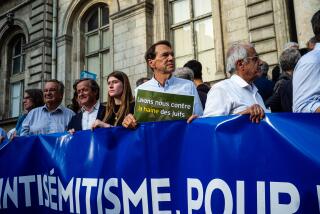Louvre’s new Islamic wing provides tonic at time of tension
- Share via
PARIS — In the midst of the furor in the Muslim world over negative Western depictions of the prophet Muhammad, the Louvre on Saturday opened a new Islamic wing chock-full of 2,500 vintage ceramics, tapestries and other treasures from Islamic cultures stretching from Spain to India.
A diverse crowd filtered into the iconic museum for the first day of the permanent exhibit, featuring a 14th century Mamluk porch, a wall of nearly 600 ceramics and only a single illustration of a veiled Muhammad, contained in a 16th century Ottoman Turkish manuscript.
For many passing through, the naturally lighted modern structure constructed for the rare, colorful objects seemed a welcome respite from the broadcast images of the last week showing flag-burning protests and tightly guarded French embassies.
“It’s a good time for this show. We’re always in conflict, whereas here, everyone has come together to share in their pleasure for beautiful things,” said Alice Brisson, 29, who said she isn’t Muslim, but is especially interested in Islamic “values.”
French President Francois Hollande last week called the new wing a “cultural” and “political” act of confidence and “of peace.”
The exhibit, he said, depicts a diverse Islamic civilization that is “more alive and more tolerant than those who abusively claim to speak in its name today. It is the exact opposite of obscurantism, which destroys principles and values of Islam through violence and hate.... With works put to the service of harmony, we understand that the best weapons for fighting the fanaticism claiming to represent Islam is within Islam itself.”
The president spoke a day before a left-leaning French weekly, Charlie Hebdo, published satirical cartoons showing the prophet Muhammad amid deadly riots against a video privately produced in the U.S. that mocked Muhammad. For more than a week, violence has broken out across the Muslim world in protests against the images from the amateurish production.
Since the publication of the French cartoons, riot police have been stationed around the weekly’s Paris headquarters, as well as mosques and other locations likely to attract protests. French schools and other institutions abroad were shut down and heavily guarded.
In many ways, the timing of the Louvre’s opening could not have been better. The Islamic wing was created with the hope of not only dazzling the eye, but also “to show the luminous side of this civilization,” the museum’s director, Henri Loyrette, said in a video statement. The exhibit’s content, he said, may help overcome a “repulsion” some people express for Islamic arts and “for Islam in particular.”
At the same time, the show doesn’t look at Islam through “rose-colored glasses,” curator Sophie Makariou said in a recent interview.
The first explanatory panel visible upon entering the new space emphasizes conquests by the Islamic empire during the 7th and 8th centuries. The word “conquests” is highlighted in bold, and a timeline of takeovers is provided with a computerized map that shows a blue light representing Islamic civilization spreading from Asia to Spain and France. Similar panels are placed throughout the exhibit for later periods.
That emphasis was striking enough that Linda Komaroff, the curator of the Islamic Art Department at the Los Angeles County Museum of Art, wondered while attending the showing whether the organizers had mistakenly highlighted the word “conquest.”
“You don’t need to talk about conquests to talk about art.... When I think of Islamic art, I don’t think of violence, so why emphasize that?” she asked, before noticing the wording on the panel. Overall, she said, the exhibit “showed a nice balance.”
The historical and cultural context of the artwork was an especially important element for the large number of visitors who gathered in a special multimedia section explaining the history of Islamic religion and civilization. The collection insists from the start that it seeks to focus on the broader civilization of Islam, and not only the faith, by trying to clearly define Islamic art as the product of a culturally and religiously diverse people. It also points out shared connections between artwork from Western and Oriental cultures.
But though the show left many impressed, the week’s news still weighed heavily on some minds.
An official request to hold a protest Saturday against Charlie Hebdo was rejected by authorities out of concern for security. As a result many Muslims complained that their right to peacefully protest had been denied because of their faith.
“They talk about freedom of speech, but that also means the freedom to protest, and we’re not given that right, even though it was officially requested according to all the rules,” said Ersin Tuzen, 35, while visiting the new wing with his sister.
“It means they are saying: ‘Shut your mouths,’ which is like putting everything inside a pressure cooker,” he said. “We aren’t treated like other citizens, even though we pay taxes like them, and shop in the same supermarkets.”
Tuzen worried that most who come to the exhibit may “already [be] interested in Islam,” but overall, he said, the new wing “can only do good.”
Some expressed a new interest in a vast and mysterious culture.
“I had no idea the Louvre had so many ceramics!” said Michel Brocard, 58, visiting from eastern France. “For me, there’s nothing really that religious here. Maybe Islamic art isn’t the right word, after all. For me, it’s more an art of a people.”
Brocard said tension had clearly increased both on the extreme right and among extremist French Muslims. So in the midst of that, he said, “we came here today for a pause, a moment to catch our breath, and we experienced it that way.”
Lauter is a special correspondent.
More to Read
Sign up for Essential California
The most important California stories and recommendations in your inbox every morning.
You may occasionally receive promotional content from the Los Angeles Times.










